- You are here:
- Home »
- Anaerobic Endurance
Tag Archives for " Anaerobic Endurance "

Possession Game with Finishing
By Alex Trukan
This practice has multiple challenges in all facets of the game. Firstly, from the conditioning point of view, it develops explosiveness and power. That is especially required when breaking through defences and around the opposition penalty box. From the technical perspective, it includes elements of passing, combination play as well as finishing. It also challenges players’ decision making on when to speed up play and try to score. Having an end product (shot on goal) makes it engaging and enjoyable for players. The practice is designed for intermediate and advanced players.
Set up and directions
Organise a 20 x 30 yards rectangle. Place two goals on the opposite ends, 15 yards away from the playing area. Divide the players into three teams of three. Two teams are positioned in the middle of the playing area and compete against each other. Third team is neutral, two players from that team are outside the area and one in the middle as shown on the diagram below. The neutral team plays with whichever team is in possession. Prepare a sufficient supply of balls.
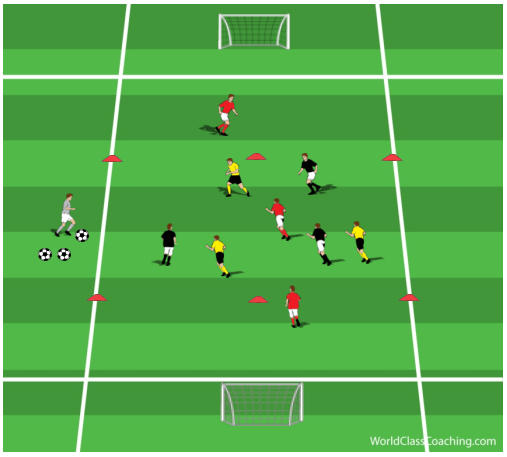
The practice starts from the coach playing the ball to one of the attacking teams (not neutral). Which team starts with the ball can be adapted to the group needs and objectives of the session.
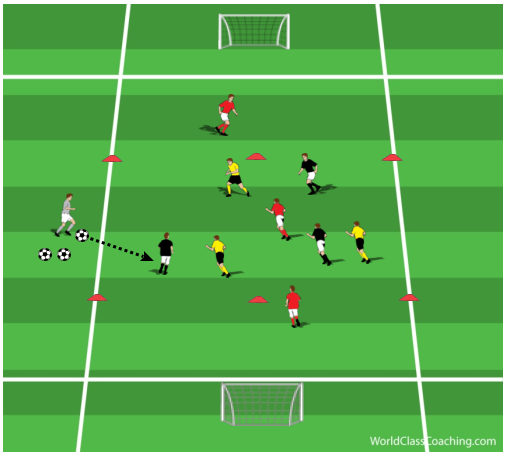
The team is possession then tries to make three passes before breaking through. The second team tries to get in possession with the same objective of making three passes. Neutral players support the team in possession of the ball.
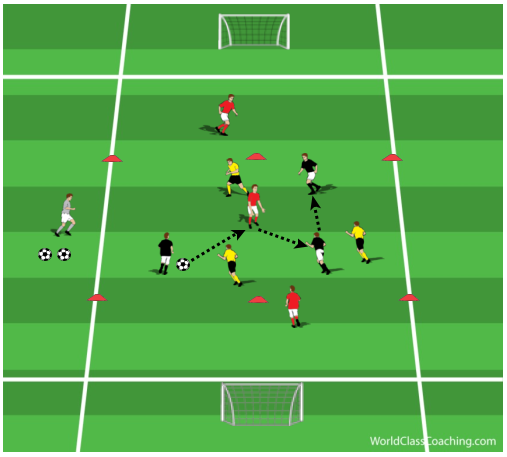
After the team makes three passes, they can play to any of the outside neutral players and break through to finish on goal. Minimum two players have to break through out of the square. The player that played the ball to the neutral player can’t be the one that finishes (forces third man run). The defending team can send out as many players as they want to stop the other team scoring. After the shot is made the practice is restarted from the coach playing the ball to the second team.
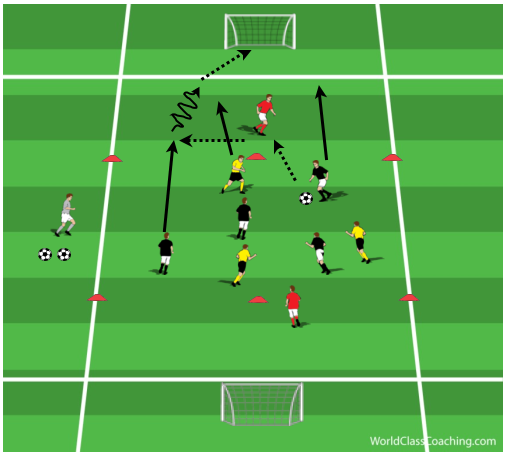
Timing
Both teams compete to ‘break’ 10 times. Every ‘break’ should last no longer than 3 seconds. That should be repeated in 2-4 series with 4 minutes break in between them.
Variations
- 4v4 in the middle
- 2 passes before the ‘break’
- Increase/decrease the distance between the playing area and goals
By Alex Trukan, Development Coach, Nottingham Forest
@AlexTrukan
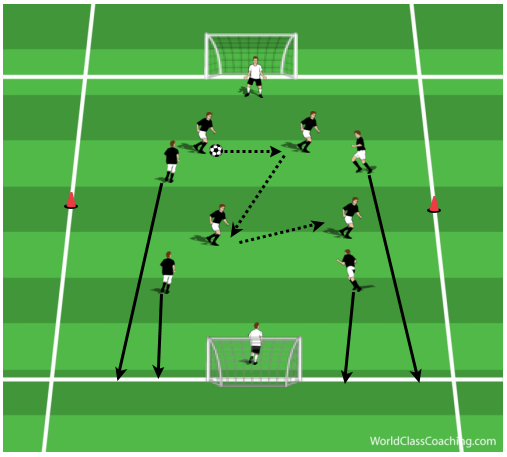
Small Sided Game to Improve Anaerobic Endurance
By Alex Trukan
The presented game is aimed at improving players’ ability to produce more high intensity actions throughout the game. This is achieved in a conditioned game which has elements of defensive transition, combination play as well as recovery runs. The organisation of this practices challenges players to react quickly when losing possession as well as combine play to attack upon winning it. This small sided game has some major tactical trade-offs, however the main area of focus is the physical corner. This practice is well suited for intermediate and advanced players.
Set-Up and Directions
Organise 30 x 40 yards pitch with two goals on the opposite ends. Mark out half way line. Divide the players into two teams of 4. Set goalkeepers in goals. The area size may be bigger if more players are involved. Prepare supply of balls.
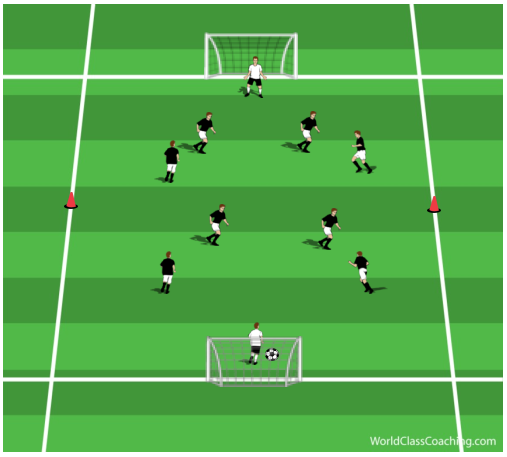
The game starts with a goalkeeper playing out to one of the players from his team. The aim of the team in possession is to score in the opposition goal. Normal rules of football apply.
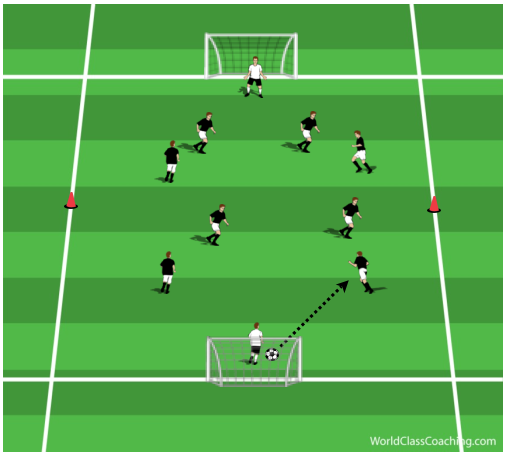
The condition of the game focuses on the moment of losing possession. If the attacking team loses the ball whether it’s after tackle or interception, all of the players from that team have to touch the line by their own goal before they can defend.
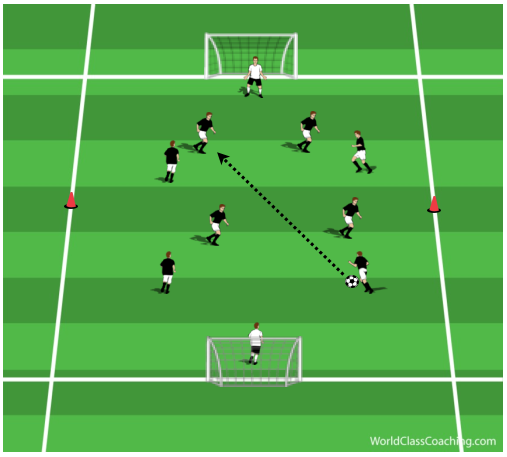
As we can see below, the reaction of the team that lost possession is to make a sprint towards own end line. The team that gained possession in turn, has to make 3 passes before they can attack and shoot.

The challenge for the defending team is to apply pressure on the attackers as soon as possible to prevent shots on target and their progression forwards.
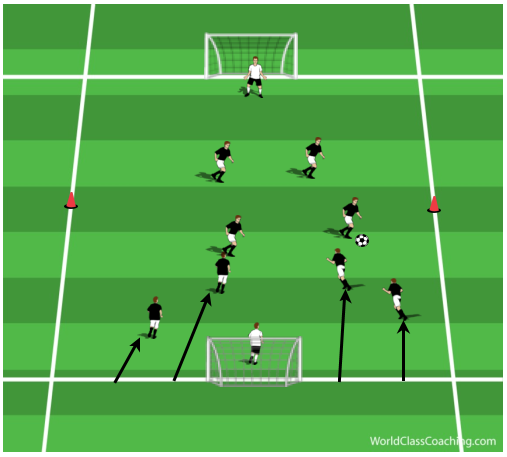
Timing
The game should be played 3 minutes and repeated 6-10 times in 2 series. The rest period between repetitions should be 1- 3 mins and between series – 4 minutes.
Variations
- 4 v 4/6 v 6
- Team that lost possession has to touch specific cone/line set by coach
- Team that won possession has to make 5 passes before making an attack
By Alex Trukan, Development Coach, Nottingham Forest
@AlexTrukan
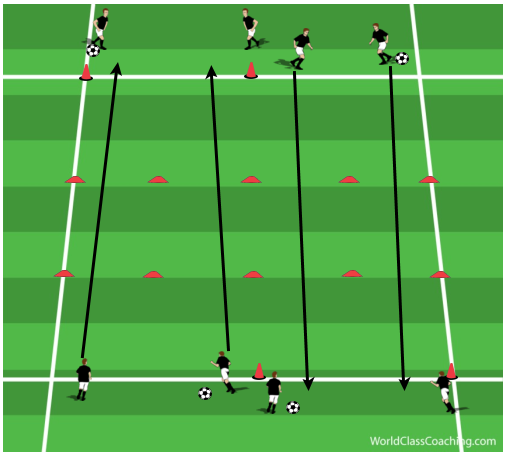
Combination Play Race
By Alex Trukan
This practice is focused on improving players’ explosiveness and anaerobic power. It is crucial conditioning component which is for example used when losing the ball and making transition to defence and during recovery runs. In addition to that, combination play element is incorporated to make the practice more realistic and add technical elements to it. The best way of organising this exercise is in the form of competition between two teams what will increase the intensity and engagement of the players.
Set up and Directions
Divide the 10 x 21 yards pitch into three thirds (7 yards long). Set up two channels on the opposite ends as shown on the diagram below. Divide the group into pairs and organise half of the pairs at the beginning of one channel and the other half at the start of the opposite channel. Each pair needs a ball.
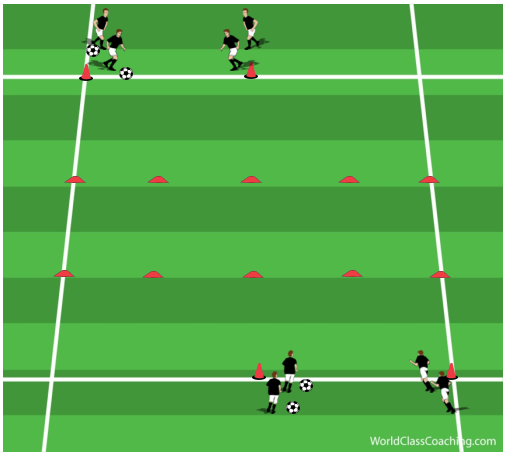
The game starts on the coach’s sign. Both pairs try to combine play through the thirds and get to the opposite end of the channel. The rule is that the ball has to be touched minimum once in every third and the ball can be only passed to the next third (no dribbling).
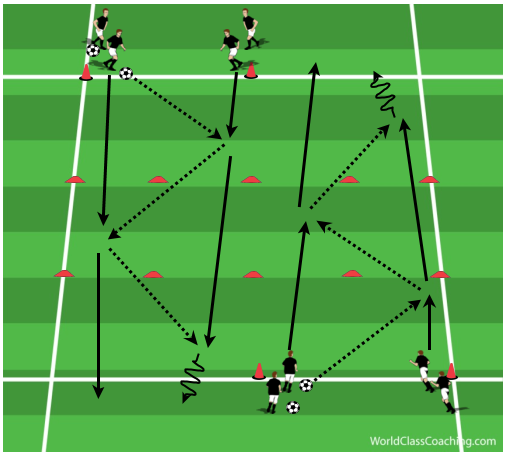
After both players have crossed the end of the channel, the ball should be left there and they should sprint as quickly as possible to the start of the channel. Whichever pair gets back first, wins the race.

Timing
Each pair should repeat the race 4-6 times in 1-2 series. The rest period between repetitions should be 1 minute (other pairs working) and between series – 4 minutes (active rest).
Variations
- Certain amount of passes to be made in each third
- Increase/decrease the distance of the channel
- Four zones instead of thirds
By Alex Trukan, Development Coach, Nottingham Forest
@AlexTrukan
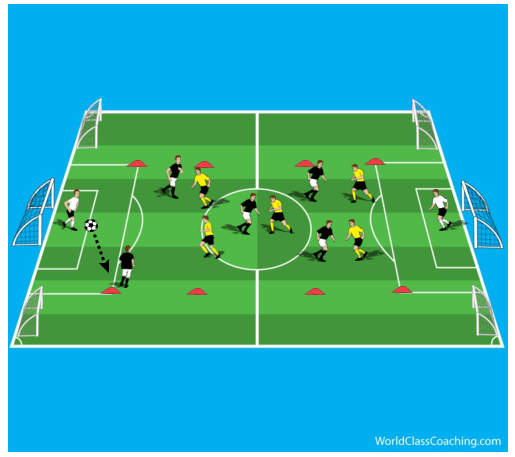
Individual Duels Game
By Alex Trukan
This game is focused on improving aerobic endurance as well as 1v1 duels. From the physical point of view, it helps players to maintain many actions throughout the whole game, what will enable them to be more involved and affect the game more even towards the end of it. From the technical perspective, this practice also incorporates 1v1 high intensity duels, what increases competitiveness and engagement. Individual duels’ game is mostly suitable for older age groups, usually from U12 upwards.
Set up and directions
Organise a 30 x 40 yards pitch with two big goals (one on each end), and four small goals (two on each end in wide areas). Cone off two wide zones, each 4 yards wide as shown on the diagram below. Divide the group into two teams of five. Place goalkeepers in goals. Prepare min. 8 balls to supply if needed. Assign individual duels for every player (i.e. right back from team A responsible for left winger from team B).
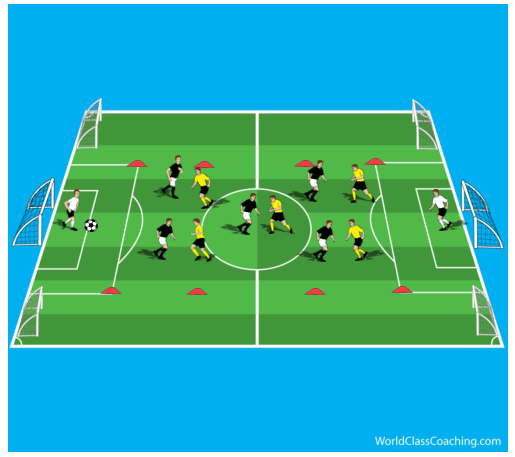
The game starts in the middle zone, no players are allowed to go into wide coned off areas. The goalkeeper plays the ball into one of the players from his team (no restrictions into who the ball should be played).

The player on the ball can decide – continue the game in the middle zone and try to score in the big goal or dribble into wide area. As soon as he dribbles into wide area, only the player that is responsible for him can go into the wide area and try to defend.
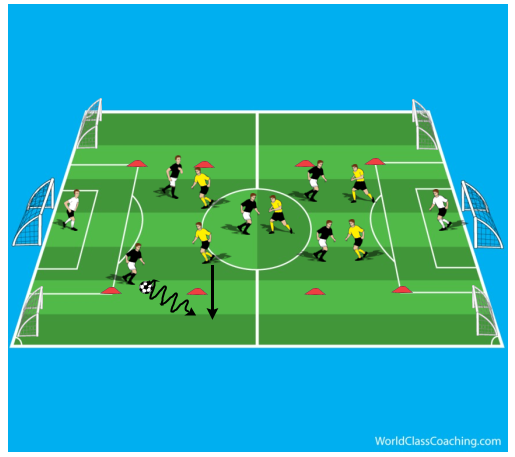
The 1v1 duel continues in the wide area with players trying to score in the opposite small goals. If the ball goes out or the goal is scored, the duel finishes and both players come back to the middle zone. At the same time as the duel is being played, a coach/goalkeeper plays second ball into the middle zone and the game continues normally (player on the ball can choose to go into other wide area).
[wpsharely id=”1886″][/wpsharely]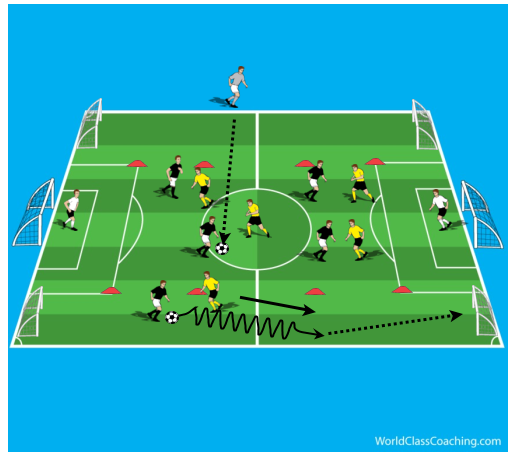
Timing
The game continues 4-8 minutes and is repeated 4-6 times with 2 minutes rest between repetitions.
Variations
- 5v5/7v7
- Increase/decrease the size of the area
- Play without the goalkeepers
By Alex Trukan, Development Coach, Nottingham Forest
@AlexTrukan
